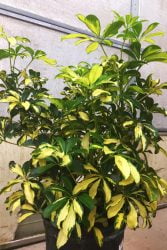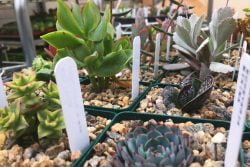
By Jesse Eastman
Whether for an office, a classroom, or your home, houseplants provide an essential connection to the natural world in what can otherwise be a fairly sterile environment. A little bit of green not only softens a room, but can increase humidity, clean air, and can even improve memory, concentration, and sleep.
Of course, a dead houseplant won’t do much good, so the challenge becomes selecting the right plant so that you and your plant thrive. When selecting a plant, there are two general approaches. The first approach assumes you have a fixed set of conditions, and you need a plant that is suitable for those conditions. The second approach assumes you have fallen in love with a certain plant and need to adapt your environment to please the plant. Either way, factors such as light, temperature, humidity, plant and room size, and maintenance requirements are all necessary considerations. Read through the discussion of these factors below, take some notes on your home or office, and then come visit fully prepared to adopt a plant into a loving and healthy habitat!

Light
The first question any good salesperson asks when helping select a houseplant is what the light is like in your home. There are many factors that affect the available light, including how near to a window the plant will sit, how many windows are in the room, what direction they face, if the eaves of the house have a deep overhang, if there are trees that block incoming light, etc. While some plants can tolerate a broad range of light conditions, others have highly specific needs. In many cases, plants can survive in less than optimal light conditions, but may look haggard and perform poorly as a result.
One important distinction is direct vs. indirect light. Direct light can burn many plants that otherwise tolerate high light situations. High light locations are spots where you can comfortably read by the natural light throughout the day. Intense light is great for plants like citrus and cactus, but can cause leaf scorch and rapid drying in many other houseplants. Moderate light locations would allow you to read by natural light depending on the time of day and how strong your eyes are. African Violets and Begonia do well in moderate light. Low light locations are generally so dim you’d always need an artificial light to read by. This is an ideal situation for Zee Zee Palm and ferns, but can cause light-loving plants to get leggy and may also result in overly wet soil, leading to a host of pest and disease problems. Fortunately, some of these problems can be offset an artificial light.
Temperature
Most houseplants hail from tropical and subtropical regions around the globe. For this reason, they tend to dislike drafty areas, especially in winter when exterior doors can allow blasts of frigid air into an otherwise well-heated home. Even plants too close to a window pane can suffer the consequence of cold winter air. On the other hand, the intensity of heat flowing from a heat vent or fireplace may be too much to bear for many plants accustomed to the stable temperatures of their native habitats. Likewise, summer heat beaming through a glass window can act like a death ray on many tender tropical – you’ve got to consider all four seasons and how they affect your indoor environment.
Humidity
Here in Colorado, we have the mixed blessing of exceptionally low humidity. It’s a wonderful place to be if you don’t like frizzy hair, but your houseplants would likely prefer to be somewhere a little damper. Add the drying effect of centrally heated/cooled houses, and you’ve got a tricky situation for some of the more tropical houseplant varieties. Plants that tolerate our dry air particularly well include Snake Plant, Chinese Evergreen, and Dracaena. If you’ve got your heart set on a moisture-loving option like a fern or an orchid, it’s time to break out the bag of tricks and elevate your humidity. If you’re not willing to install a whole house humidifier, humidity trays are a great way to create a pocket of humid air around individual plants. Grouping plants together can also serve to elevate ambient humidity, as plants release moisture into the air as a part of the photosynthesis process. Use caution though, as plants touching one another may transfer pests and disease, and if too many plants are clustered too tightly, airflow can become restricted, elevating the pest and disease risk. Periodically misting plants can help too, but the effect does not last for long.

Size & Growth Habit
You probably know someone who bought an adorable puppy only to watch it grow into a slobbering hairy behemoth that didn’t really fit into their one bedroom apartment. The same can happen with plants (minus the shedding and drooling). That’s why it’s important to learn about mature size when selecting a new houseplant. Even though a baby Schefflera Amate is cute right now, given ideal conditions it can reach 40’ tall (but can be kept a manageable size with pruning). A Snake Plant, though, will never get more than 3’-4’ tall, not matter how much you talk to it and encourage it.
Also important is growth habit. If you’re the type of person who tends to overwater, choose a thirsty plant like Schefflera or Anthurium. Love to prune? Again, Schefflera is a good option, as are many bonsai plants. On the other hand, if you tend to neglect plants (pro tip: we all forget to water our plants sometimes), opt for something that prefers to be left alone like a Cast Iron Plant or many varieties of succulent. Also consider whether your plant has an upright or trailing growth habit. Trailing plants like Lipstick Plant or Wandering Jew are great for hanging baskets and high shelves, while upright plants such as Parlor Palm make strong statements in large floor-sitting pots.
No matter your needs, a little bit of planning will go a long way in terms of the success of your future photosynthesizing friend. Once you’ve done your homework, come see us. We promise we’ll be impressed at how prepared you are!
Originally published on February 1st, 2017.
